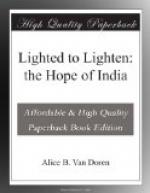A woman still young, though mother of seven living children, is carried into the maternity ward of the Woman’s Hospital. At the hands of the ignorant mid-wife she has suffered maltreatment whose details cannot be put into print, followed by a journey in a springless cart over miles of rutted country road. She is laid upon the operating table with the blessed aid of anaesthetics at hand; there is still time to save the baby. But what of the mother? Only one more case of “too late.” Pulseless, yet perfectly conscious, she hears the permission given to the relatives to take her home, and knows all too well what those words mean. The Hospital has saved her baby; her it cannot save. Clinging to the doctor’s hand she cries:
“Oh, Amma, I am frightened. Why do you send me away? I must live. My little children,—this is the eighth. I don’t care for myself, but I must live for them. Who will care for them if I am gone? Oh, let me live!”
And the doctor could only answer, “Too late.”
On that road where the doctor passes by, one day she saw a beautiful boy of one year, “the only son of his mother.” The eyelids were shut and swollen. “His history?” the doctor asks. Ordinary country sore eyes that someway refused to get well; a journey through dust and heat to a distant shrine of healing; numberless circlings of the temple according to orthodox Hindu rites; then a return home to order from the village jeweller two solid silver eyeballs as offerings to the deity of the shrine. Weeks are consumed by these doings, for in sickness as in health the East moves slowly. Meantime the eyes are growing more swollen, more painful. At last someone speaks of the weekly visit of the doctor on the Gudiyattam Road.
The doctor picked up the baby, pushed back the swollen eyelids, and washed away the masses of pus, only to find both eyeballs utterly destroyed. One more to be added to the army of India’s blind! One more case of “too late”! One more atom in the mass of India’s unnecessary, preventable suffering,—that suffering which moved to compassion the heart of the Christ. How many more weary generations must pass before we, His followers, make such incidents impossible? How many before Indian women with pitying eyes and tender hands shall have carried the gift of healing, the better gift of the health that outstrips disease, through the roads and villages of India?
[Illustration: Freshman Class at Vellore]
[Illustration: Latest Arrivals at Vellore]
The existence of the Medical School has been made possible by the gifts of American women. Its continued existence and future growth depend upon the same source. Gifts in this case mean not only money, but life. Where are those American students who are to provide the future doctors and nurses not only to “carry on” this school as it exists, but to build it up into a great future? It is to the girls now in high school and college that the challenge of the future comes. Among the conflicting cries of the street and market place, comes the clear call of Him whom we acknowledge as Master of life, re-iterating the simple words at the Lake of Galilee, “What is that to thee? Follow thou me.”




